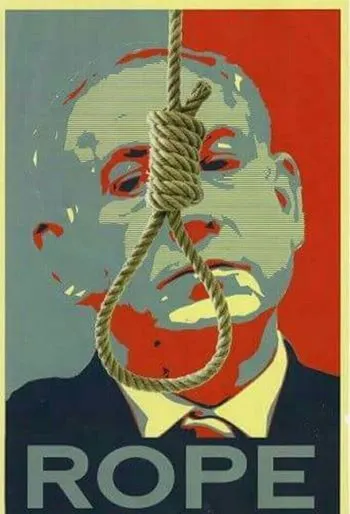History has embedded specific powers into objects. Every fork and spoon has a story, and Museums are full of objects that played a significant part in societal change—the spear that pierced Jesus’ side, the rope that hung Ned Kelly and Dundalli. Superstitions and folklore surround objects and places involved in death; some biblical, some historical, some from everyday life.
We once held my friend Wave’s brand-new expensive mountain bike down with packing tape, then watched it fly off the roof rack of Tim’s Kombi only to be run over by a truck before it could be rescued. It was not surprising Wave’s bike did not hold. Wave said that if we went for a swim his bike would have stayed on the roof, the magical ceremony of a swim twisting strength into the plastic fibres of the packing tape? We will never know.
The death of Wave’s bike has led me to believe that part of being prepared for life meant owning a good piece of rope. Since then, on the floor of the car behind the driver’s seat I have always kept a length of it. It is not the best quality nylon rope, ¾ inch, blue and white, good enough for tying things I find on the side of the road to the roof rack. Maybe this will give them a better chance of life than Wave’s Mountain bike. It’s not magic.
Many stories exist about the magical powers embedded in rope used to hang people. In Britian, the rope that they used typically was 19mm Italian hemp. The hemp fibres are twisted together and then treated with a mixture of water, oil and wax to make the rope more pliable and resistant to weathering. Powerful cures are twisted into the fibres. Hangmen’s ropes are believed to be a cure for sore eyes (Cornwall), fits and headaches (Pennsylvania), and ague (London). In Russia, a hangman’s rope brought luck to gamblers.
People from St Louis believed that hanging rope could cure rheumatism, consumption, heart disease, apoplexy, and everything else. Hanging rope could also be a hoodoo and bring bad luck to whoever held the rope. The following is a story of one man who held a noose that strangled the idea of peace.
A Peace of Rope
In September of 1993 the Oslo peace accord was signed. Norway got the job facilitating from having a connection to both the Israeli government and the Palestinian Liberation Organisation, led by Yasser Arafat. When the Iranian Shah had to flee into exile in 1979, Israel lost one of its main oil suppliers, and Norway became their supplier instead. To do this, Norway was forced to make a deal with Arafat, as Norway had soldiers in Beirut fighting for Lebanon. Yasser Arafat gave permission, as long as Norway promised to act as a negotiator between Israel and the PLO.
Meetings for the peace accord were held in secret from 1988, which was the second year of the Intifada, by which time Israel was facing international pressure for its treatment of Palestinians. By 1991, the Gulf war led to the PLO being extremely weak, especially compared to Israel and had to make more concessions.
The Oslo peace accord ended up being a bad deal for Palestine. It didn’t restrict the settlement by Israel, it did not give the Palestinians a nationhood, and it split the West Bank into a number of territories, with a bypass that makes it possible for Israelis to travel through the territory unhindered. What the peace accord did achieve was 100,000 Palestinian refugees being able to return, and they established the Palestinian Authority. These concessions were protested by Hamas who wanted Palestinian statehood and autonomy, leading to Hamas using suicide bombers in retaliation.
The Rope and the Coffin
The peace accord was signed in Washington by Yitzhak Rabin, Yasser Arafat and Bill Clinton. Yitzhak Rabin was the prime minister of Israel. Benjamin Netanyahu was in opposition. In response, Netanyahu led right wing extremist marches holding a noose and a coffin, calling for the death of Yitzhak for even considering peace. These religious conservatives and Likud party leaders believed that withdrawing from any ‘Jewish’ land was heresy.
The right-wing rabbis viewed the peace process as a capitulation to Israel’s enemies and forbade the Israel Defence Forces from evacuating Jewish settlers. Along with Benjamin Netanyahu they declared Rabin as a ‘rodef’, one who is intent on murdering someone. This invokes the law ‘din rodef’, the law of the pursuer, which allows for extrajudicial killings. Along with Netanyahu leading the march with a coffin and a noose, people were chanting ‘Rabin is a murderer, Rabin is a traitor’, and ‘Death to Rabin.”

Netanyahu was warned about his hateful rhetoric leading to violence which Netanyahu declined to do. Netanyahu denied any intention to incite violence. Netanyahu marched with a coffin and a hangman’s noose.
The Rope and the Song
Netanyahu became prime minister in 1996, and since then Israel has not followed the Oslo Accord, increasing settlement in the West Bank, restricting the movement of Palestinians and building separation walls in the West Bank. In Gaza they imposed a total land air and sea blockade.
After a historic rally, with 100,000 Israelis rallying for peace and singing songs of peace to celebrate the Oslo Accords at the Kings of Israel Square in Tel Aviv, Rabin was assassinated in the carpark. The murderer was an ultra-nationalist who radically opposed peace particularly the signing of the Oslo accords. Found in his pocket was a blood-stained piece of paper with the lyrics to the Song of Peace sung at the rally.

No object is more prominent in Palestinian history than Netanyahu’s noose, the piece of rope that strangled the idea of peace. The unluckiest, and most destructive piece of rope that exists. If I could ask Netanyahu a question, it would be about the rope. What was it made of? Where is it now? The blood-stained sheet of paper with the lyrics to the Israeli song ‘Shir LaShalom’ (Song of Peace) that was found in Rabin’s pocket will be remembered. The rope has already been lost to history.
Shir Lashalom (Song of Peace)
Let the sun rise
Light up the morning
The purest of prayers
Will not bring us back
He whose candle was snuffed out
and was buried in the dust
bitter crying won’t wake him up
and won’t bring him back.
Nobody will bring us back
From a dead and darkened pit here.
Neither the victory cheer
Nor songs of praise will help
So just sing a song for peace
Don’t whisper a prayer
Just sing a song for peace
In a loud shout.
Allow the sun to penetrate
through the flowers
don’t look back
let go of those departed
Lift your eyes with hope
not through the rifles’ sights
sing a song for love
and not for wars
Don’t say the day will come
bring on that day –
because it is not a dream –
and in all the city squares
cheer only for peace!

